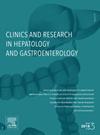评估暴露于SARS-CoV-2感染患者肝功能和结构的长期变化:一项前瞻性研究
IF 2.4
4区 医学
Q2 GASTROENTEROLOGY & HEPATOLOGY
Clinics and research in hepatology and gastroenterology
Pub Date : 2025-05-01
DOI:10.1016/j.clinre.2025.102606
引用次数: 0
摘要
背景,目的:严重急性呼吸综合征冠状病毒-2 (SARS-CoV-2)结合血管紧张素转换酶-2 (ACE2)受体靶向多种器官,包括肝脏。肝损伤是SARS-CoV-2急性感染的共同特征。一些研究还描述了既往COVID-19患者的慢性肝脏改变。我们假设在COVID-19患者中观察到的脂肪变性反映了他们的代谢特征,而不是由SARS-CoV-2持续的炎症引起的。方法开展前瞻性研究,评估COVID-19住院患者肝功能和结构的长期变化。入院期间纳入既往无已知肝病合并轻至中度COVID-19的患者,并在16个月左右的随访期间重新评估。在基线和随访期间比较了代谢谱、BMI、酒精消耗和身体活动的全血检。在住院期间和随访期间获得特定的超声扫描,使用Steatoscore2.0来量化脂肪变性。结果55例符合条件的患者中,33例纳入分析,只有3例(9%)在随访中有新的脂肪变性诊断。脂肪score2.0从基线到随访无显著变化(1.7 vs 1.73, p = 0.348),而IPAQ问卷估计的体重指数和体力活动发生了变化(26.3 vs 26.6 kg/m2, p = 0.005;540 vs 480, p = 0.015)。总胆固醇(144.5 vs 187.0 mg/dl, p = 0.003)和低密度脂蛋白胆固醇(73.8 vs 113.9 mg/dl, p = 0.003)有统计学意义的增加。随访时炎症指标恢复正常,包括c反应蛋白(41.1 vs 0.8 mg/L, p <;0.001),铁蛋白(410.0 vs. 91.0 ng/dl, p <;0.001)。4例患者的肝转氨酶水平在基线时上升了3倍,这在随访中未得到证实。作为胰岛素抵抗的替代指标,脂肪score2.0的变化与甘油三酯-葡萄糖指数显著相关。结论在我们的研究中,未观察到既往SARS-CoV-2感染患者的长期功能和结构变化。新冠肺炎后代谢谱明显恶化本文章由计算机程序翻译,如有差异,请以英文原文为准。
Evaluation of long-term changes in liver function and structure in patients exposed to SARS-CoV-2 infection: A prospective study
Background & Aims
Severe acute respiratory syndrome-coronavirus-2 (SARS-CoV-2) binds to Angiotensin Converting Enzyme – 2 (ACE2) receptor targeting various organs including liver. Liver injury is a common feature of SARS-CoV-2 acute infection. A few studies have also described chronic hepatic alterations in patients with previous COVID-19. We hypothesize that steatosis seen in COVID-19 patients reflects their metabolic profile and is not caused by persistent inflammation sustained by SARS-CoV-2.
Methods
We conducted a prospective study to evaluate long-term changes in liver function and structure in patients hospitalized for COVID-19. Patients without a prior known hepatic disease with mild to moderate COVID-19 were enrolled during hospitalization and reevaluated during a follow-up visit at a medium 16 months. Complete blood panels with metabolic profile, BMI, alcohol consumption and physical activity were compared between baseline and follow-up. Specific ultrasound scans were obtained during hospital stay and at follow-up to quantify steatosis using Steatoscore2.0.
Results
Among 55 eligible patients, 33 were included in the analysis and only 3 (9 %) had a new diagnosis of steatosis at follow-up. Steatoscore2.0 did not change significantly from baseline to follow-up (1.7 vs 1.73, p = 0.348), while changes occurred in body mass index and physical activity estimated by IPAQ questionnaire (26.3 vs 26.6 kg/m2, p = 0.005; 540 vs. 480, p = 0.015, respectively). There was a statistically significant increase in total cholesterol (144.5 vs 187.0 mg/dl, p = 0.003) and low-density lipoprotein-cholesterol (73.8 vs 113.9 mg/dl, p = 0.003). Inflammatory markers normalized at follow-up, including C-reactive protein (41.1 vs. 0.8 mg/L, p < 0.001), and ferritin (410.0 vs. 91.0 ng/dl, p < 0.001). Four patients had a 3-time rise in liver transaminase levels at baseline, and this was not confirmed at follow-up. Change in Steatoscore2.0 correlated significantly with Triglyceride-glucose index as a surrogate of insulin resistance.
Conclusions
In our study, long term functional and structural changes were not observed in patients with previous SARS-CoV-2 infection. There was a significant deterioration of metabolic profile post COVID-19
求助全文
通过发布文献求助,成功后即可免费获取论文全文。
去求助
来源期刊

Clinics and research in hepatology and gastroenterology
GASTROENTEROLOGY & HEPATOLOGY-
CiteScore
4.30
自引率
3.70%
发文量
198
审稿时长
42 days
期刊介绍:
Clinics and Research in Hepatology and Gastroenterology publishes high-quality original research papers in the field of hepatology and gastroenterology. The editors put the accent on rapid communication of new research and clinical developments and so called "hot topic" issues. Following a clear Editorial line, besides original articles and case reports, each issue features editorials, commentaries and reviews. The journal encourages research and discussion between all those involved in the specialty on an international level. All articles are peer reviewed by international experts, the articles in press are online and indexed in the international databases (Current Contents, Pubmed, Scopus, Science Direct).
Clinics and Research in Hepatology and Gastroenterology is a subscription journal (with optional open access), which allows you to publish your research without any cost to you (unless you proactively chose the open access option). Your article will be available to all researchers around the globe whose institution has a subscription to the journal.
 求助内容:
求助内容: 应助结果提醒方式:
应助结果提醒方式:


